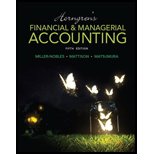
Concept explainers
1.
No-par
Common stock: These are the ordinary shares that a corporation issues to the investors in order to raise funds. In return, the investors receives a share of profit from the profits earned by the corporation.
Par value: It refers to the value of a stock that is stated by the corporation’s charter. It is also known as face value of a stock.
To Journalize: the issuance of common stock for Incorporation W.
To Journalize: the issuance of no-par preferred stock for Incorporation W.
To journalize: the purchase of land in exchange common stock issuance by Incorporation W.
2.
To Prepare: the stockholders’ section of the
Want to see the full answer?
Check out a sample textbook solution
Chapter 13 Solutions
Horngren's Financial & Managerial Accounting (5th Edition)
- Not use ai solve this question general Accountingarrow_forwardCalculate the annual depreciation expensearrow_forwardA company purchases a machine for $150,000. It is estimated that the machine has a useful life of 10 years and will then be sold for $12,0000. Using the straight-line method, calculate the annual depreciation expense to be charged for each year of useful life. A. $13,800 B. $1,380 C. $12,500 D. $15,000 need helparrow_forward
- Principles of Accounting Volume 1AccountingISBN:9781947172685Author:OpenStaxPublisher:OpenStax College
